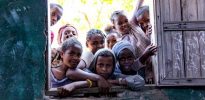An estimated 36 million of a total population of 41 million children under the age of 18 in Ethiopia are multi-dimensionally poor, says a new report by a government agency and the UN agency for UN children.
The report indicated that the children are deprived of basic goods and services in at least three dimensions. The report studied child poverty in nine dimensions – development/stunting, nutrition, health, water, sanitation, and housing. Other dimensions included education, health related knowledge, and information and participation, according to the study conducted by the Central Statistics Agency and UNICEF.
The study, “Multi-dimensional Child Deprivation in Ethiopia – First National Estimates,” finds that 88 per cent of children in Ethiopia under the age of 18 (36 million) lack access to basic services in at least three basic dimensions of the nine studied, with lack of access to housing and sanitation being the most acute.
Given their large population sizes, Oromia, Amhara, and Southern regions are the largest contributors to multi-dimensional child deprivation in Ethiopia.
These three regions jointly account for 34 of the 36 million deprived children in Ethiopia, with Oromia having the highest number at 16.7 million, SNNPR at 8.8 million, and Amhara at 8.5 million. Regions with the lowest number of poor children are Harar at 90,000, Dire Dawa at 156,000, and Gambella at 170,000.
“We need to frequently measure the rates of child poverty as part of the general poverty measures and use different approaches for measuring poverty. This requires all stakeholders from government, international development partners and academic institutions to work together to measure, design policies and programmes to reduce child poverty in Ethiopia,’’ said Mr Biratu Yigezu, Director General of Central Statistics Agency.
The report adapted the global Multi-Dimensional Overlapping Deprivation Analysis (MODA) methodology and used information available from national data sets such as the Ethiopian Demographic and Health Surveys of 2011 and 2016. MODA has been widely used by 32 countries in Africa to analyze child well-being.
The methodology defines multi-dimensional child poverty as non-fulfilment of basic rights contained in the UN Convention on the Rights of the Child and concludes that a child is poor if he or she is deprived in three to six age-specific dimensions.
The report’s findings have been validated through an extensive consultative process involving the Ministry of Women, Children and Youth, National Planning Commission, the Ministry of Labour and Social Affairs together with the Economic Policy Research Institute, among others.
“Children in Ethiopia are more likely to experience poverty than adults, with distressing and lifelong effects which cannot easily be reversed,” said Gillian Mellsop, UNICEF Representative in Ethiopia.
“Ethiopia’s future economic prosperity and social development, and its aspirations for middle income status, depend heavily on continued investments in children’s physical, cognitive and social development.”
The study reveals that there are large geographical inequalities: 94 per cent children in rural areas are multi-dimensionally deprived compared to 42 per cent of children in urban areas.
Across Ethiopia’s regions, rates of child poverty range from 18 per cent in Addis Ababa to 91 per cent in Afar, Amhara, and SNNPR. Poverty rates are equally high in Oromia and Somali (90 per cent each) and Benishangul-Gumuz (89 per cent).
Additional key findings from the report indicate:
High disparities across areas and regions of residence in terms of average number deprivations in basic rights or services.
For example, the differences in deprivation intensity (average number of deprivations in basic rights and services that each child is experiencing) between rural and urban areas are significant; multi-dimensionally deprived children residing in rural areas experienced 4.5 deprivations in accessing basic rights and needs on average compared to 3.2 among their peers in urban areas;
Although there has been progress in reducing child deprivation, much more remains to be done. The percentage of children deprived in three to six dimensions decreased from 90 per cent to 88 per cent between 2011 and 2016 and the average number of deprivations that each child is experiencing decreased from 4.7 to 4.5 dimensions during the same period.
Most children in Ethiopia face multiple and overlapping deprivations. Ninety-five per cent of children in Ethiopia are deprived of two to six basic needs and services, while only one per cent have access to all services. Deprivation overlaps between dimensions are very high in rural areas and among children in the poorest wealth quintiles.
The report makes the following recommendations:
- Speed up investments to reduce child poverty by four per cent each year for the next decade if Ethiopia is to achieve the Sustainable Development Goal on poverty reduction;
- Accelerate investments in social sectors prioritizing child-sensitive budgeting at the national and regional levels to enhance equality and equity; and
- Improve collaboration among different social sectors to ensure that the multiple needs of children are met.

